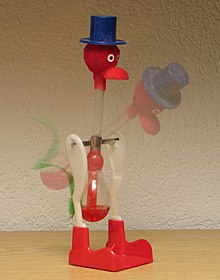Drinking bird
A drinking bird (also known as "Wippvogel", "Pickvogel", "Schluckspecht", "Trinkstorch", "Nickente", "Nickvogel" or "Glass piston duck", English "drinking bird") is a physical toy.
construction
The drinking bird is usually constructed as a hollow body made of glass, consisting of a neck that merges at the top into a felt-covered head with a beak and protrudes at the bottom into a (closed) belly, which without air contains a liquid with a low boiling point close to room temperature (e.g. ether , not approved in the EU) is filled. The bird lies on a frame and can tip forward about an axis of rotation above the belly. If it tips forward far enough, its beak protrudes into a water glass in front of it.
functionality
The water on the damp beak evaporates into the outside air and cools the beak slightly. Because of the reduced temperature, ether vapor condenses in the head and the pressure in the head drops, causing the colored liquid to rise up in the glass tube. This raises the center of gravity, the bird becomes unstable, tilts forward into the inclined position and the beak dips into the water glass that is waiting. At the same time, due to the inclination, the lower end of the tube moves out of the liquid in the abdomen, so that pressure equalization can take place. As a result, liquid flows back into the stomach and steam rises into the head, the bird tilts back to its starting position. He oscillates around the starting position and the process starts all over again.
The small temperature difference between the wet beak and the belly is sufficient to lift the liquid about 10 cm. The reason for this is that the vapor pressure of a liquid (described by the Clausius-Clapeyron equation ) depends very much on the temperature. Since the bird is only filled with a liquid and its vapor, a pressure is established in equilibrium inside the bird, which corresponds exactly to the vapor pressure of the substance at the corresponding temperature. If the beak is cooled by the moistening, vapor condenses into liquid inside there until the lower vapor pressure is established, while liquid evaporates into gas in the abdomen in order to maintain the higher pressure.
The selected liquid must be easily evaporable at room temperature, i. that is, their vapor pressure at room temperature is about the same as atmospheric pressure. Their vapor pressure must also increase sensitively with temperature. Ether would be suitable, but it is flammable, dichloromethane is harmful to the environment, therefore colored mixtures that are kept secret are used.
If the drinking glass is filled with alcohol, the bird drinks more often because the alcohol evaporates more easily than water and thus creates a greater temperature gradient. The tilting movement can also be triggered by targeted heating of the lower body with a hairdryer or by thermal radiation.
The drinking bird is a heat engine that uses the temperature difference by evaporation of water into the environment. Here it becomes clear that the indoor air or outside air, if it has less than 100% relative humidity , is not in thermodynamic equilibrium when liquid water is present at the same time , i.e. processes can take place according to the 2nd law of thermodynamics that change the state in the direction of bring thermodynamic equilibrium with 100% humidity. This imbalance is maintained by the energy of the sun, which repeatedly heats and cools the air masses, so that the moisture rains off and the air is thereby dried. In a closed system , the relative humidity soon reaches 100% and the cooling evaporation process comes to a standstill. This can easily be shown by a glass bell put over the bird: after a few minutes the movement comes to a standstill. If you remove the bell, the bird starts moving again.
literature
- Wolfgang Bürger : The paradoxical egg boiler. Physical gadgets from Professor Bürger's cabinet. Birkhäuser, Basel et al. 1995, ISBN 3-7643-5105-5 , pp. 154-161.
- J. Güémez, R. Valiente, C. Fiolhais, M. Fiolhais: Experiments with the drinking bird. In: American Journal of Physics. Vol. 71, No. 12, 2003, pp. 1257-1267, doi : 10.1119 / 1.1603272 .
Web links
- Drinking duck: demonstration experiment (experiment instructions and video)
- Thermodynamic basics of the rocker: Clear explanation in eight minutes


